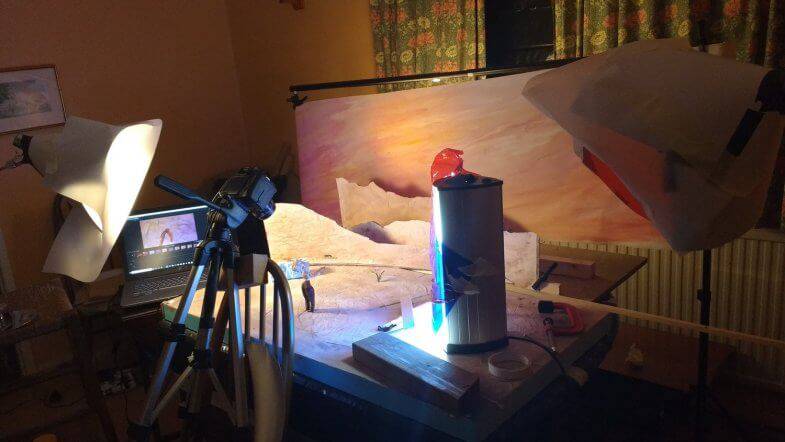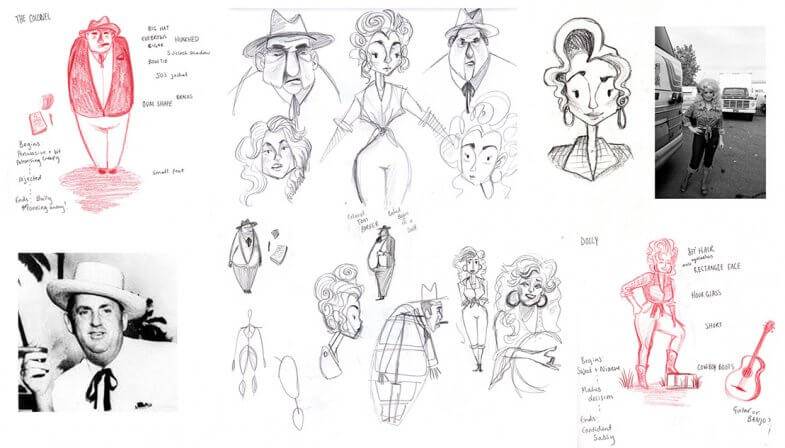Q&A: The Musical Animations of Heather Colbert
Today on Skwigly we meet UK-based illustrator and animator Heather Colbert. Having graduated from the Cambridge School of Art in 2016, the past year has proved to be a busy one with a focus on animated music videos. A protégé of directors Joseph Wallace and Péter Vácz, Heather’s work similarly embraces the principles of auteur stop-motion production, including her recent music video for Mark Nevin’s Dolly Said No To Elvis, largely produced in her grandmother’s dining room. With other projects including Ori Dagan’s Bibimbap, the experimental hand-drawn piece Konnichiwa for Matthew Evans and her own graduation film Courage to Make a Fool, Skwigly were keen to learn more about the strides this talented new artist has been making.
https://vimeo.com/236143007
How did you get involved with Mark Nevin?
Mark initially approached Joseph Wallace – having seen his breathtaking Sparks music video Edith Piaf (Said it Better Than Me) – and because Joseph was focusing on his new short, he very kindly passed the opportunity to pitch for Dolly on to me. We had a chat on the phone about the true story surrounding Dolly Parton’s song I Will Always Love You, and Mark explained that he wanted the video to reflect the self-belief and strength the young Dolly showed in protecting her publishing rights.
What was the story behind the song and how did that come through in the film?
Elvis Presley’s manager – the formidable Colonel Tom Parker – approached Dolly Parton with a great opportunity to have Elvis record her song, ‘I will always love you’, but on condition that they would take 50% of the publishing rights. At the time she was successful, but not yet in the league of Elvis, so it took extraordinary strength of character and belief in the value of her work to refuse. Mark cleverly weaves a happy ending into the song, reminding us that later on, when Whitney Houston recorded it for The Bodyguard, it became ‘the best selling single by a woman in music history’! She has since said she would have loved to hear Elvis sing it, but she just was not willing to be moved on the publishing rights. So the strength of the story is in its truth – if I had veered away from it too far, I think the video would not have such an uplifting ending when you know Dolly has triumphed. However, I wanted to elevate the tale for the video, and go further than a straight retelling of the story in the song. So when I listened to it on repeat, I could see the balance of power in the conversation shifting throughout the narrative. I saw a naive Dolly being belittled by the intimidating Colonel, and then eventually I saw a confident Dolly, towering over the tiny Colonel who has lost all his bluster!
You recently worked on Joseph Wallace’s music video for Sparks, Edith Piaf (Said it Better Than Me), how did working on that project affect your work?
I have learnt so much from Joseph; through the Edith Piaf project and then when I took part in his and Petér Vácz’s workshop at Primanima Festival near Budapest. Through these experiences, I learnt to pace my work: to keep strict time limits on each stage of the process, which helps avoid getting lost in the detail (I often did this in my uni projects!); meaning that I could realistically create ‘Dolly’ in 2 months. Also the opportunity to work alongside, and learn from other stop motion animators, to talk with people who are in love with this medium as much as I am made me think; maybe this isn’t a fluke, maybe I could do this.

Dolly Said No To Elvis set (via heather-colbert.com)
What is it about working with a strong lyrical song that interests you?
So far I have said yes to every animation project I’ve had the opportunity to make, to gain as much experience as possible. I did make a more experimental 2D music video for an instrumental track in between these two stop motion projects, to explore another part of my practice, but it’s not online yet. The strong themes in the lyrics of these two stop motion projects have been useful jumping off points; they both had a firm foundation to build up from. I embraced the challenge of making videos with clearly defined topics to work within, but equally I’d love to improve my process of creating a narrative completely from scratch.
Can you tell me a little about the puppet and set production? What materials/techniques did you use?
I had learnt a lot about puppet and set design from making my previous music video, Bibimbap (by Ori Dagan) – but most of it was what NOT to do again! The full Ori puppet was still quite heavy in the end so that meant a lot of rig removal in post-production. The puppets in Dolly were still not straightforward (I had to start the Colonel again a day before I was meant to be shooting!) but I made test puppets to play with the new materials, and created a full wire skeleton to give them strength. I used a lightweight foam (and wadding for the Colonel) to build up the body shapes, and grab points made of epoxy resin for easier manipulation. Also discovering Paper Clay for Dolly’s big hair-do was very fortunate. The costumes were a mixture of black wrap, old tights fabric and tissue paper – as I had learnt through my graduation film about the ‘wind tunnel’ effect that loose fabric can create. The set making was where I tried to implement the concept I learnt (working for Joseph) of ‘lensing up’. I made a selection of paper hills, bushes, rocks and fences in various scales, so I could build up the landscape in each shot, hopefully to expand the location beyond my grandma’s dining table!

Initial sketches and reference images (via heather-colbert.com)
You have a lovely, delicate way of weaving different types of animation together to create your films, why do you choose to work in this way?
Thank you so much! Most of the time it’s because I love them both and I just want to do ‘all the things’! I really enjoy working in both mediums, and finding ways to use them as a visual language – to tell a story within a story, or to temporarily take the audience out of the ‘real’ world created by the stop motion. Most of my work through university was hand drawn, so I have more experience in that method. In the case of Dolly, the 2D element was very useful to show the transition between the two eras, and to simply show the song passing to Whitney with Dolly’s blessing.
Can you tell me a little about your previous work, namely your student film Courage to Make a Fool?
My graduation film was a learning right angle! I knew I wanted to create a stop motion world that looked like it had been there for years, and I’ve always been fascinated by the life of performers on and off the stage. But in order to create Courage to Make a Fool I had to learn as much as I could about stop motion from YouTube, and the rest by making mistakes. I embraced what was possible with my lack of experience, and focused on learning how to convey the emotion and the story through these puppets. I am proud of the characters and the world I created, as they do look exactly how I had imagined them in my head, but I know I could give them better performances now. I was so scared of the movements looking jerky that I slowed everything down to a strange ethereal pace!
What are the main influences on the aesthetic style of your films?
The way textures of real materials interact with the light is the most exciting thing about stop-motion for me. Watching programmes by Small Films as a child, such such as Bagpuss and The Clangers, really ignited that fascination with texture. More recently Jamie Caliri’s exploration of the capacities of fabric and paper in stop motion are a real motivation. I am also hypnotised by the work of the artist Paul Kidby, who is most well known for his artwork for Terry Pratchett’s Diskworld novels. His talent for capturing the essence of a character, drawing faces that have been lived in, and eyes that let you look right into their soul, is extraordinary.
What are you working on currently/soon?
At the moment I am working as a studio supervisor at Anglia Ruskin University which has been really rewarding. It’s also good for my mental health to have a space to breathe after these intense solo projects! I’m using the time to work on other puppet-based commissions around Cambridge and to develop other possible animation projects. Ever since the Primanima workshop I have been collaborating with Abel Carbajal as a character designer for his graduation film, and I am about to travel to his university to make the puppets with him. It’s been another real education because as he is studying at ESCAC near Barcelona, his project has a proper budget! So together we have been learning the industry standard methods of puppet making for his film – a very different experience to me ‘busking it’ on my own with wire and Sculpey! It will be so great to work on something as part of a team again.
See more of Heather Colbert’s work at heather-colbert.com

